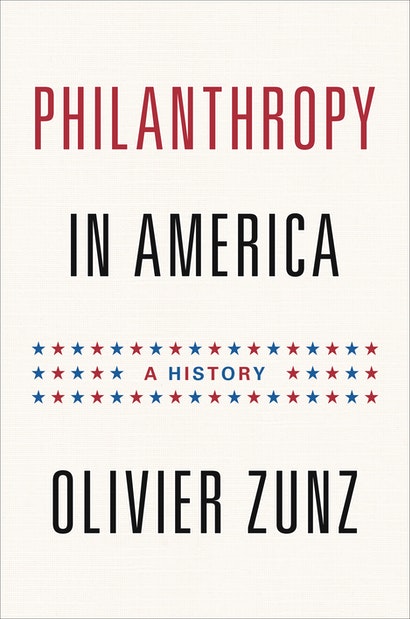A quiz to start with: What do Americans fund every year at levels comparable to annual budget of the Pentagon? Answer: the non-profit sector.

Olivier Zunz drops that small, astonishing fact at the beginning of his splendid history of philanthropy and it serves as a double reminder: first, philanthropy in the United States has grown to be an enormous enterprise; and second, we don't have a comprehensive sense of its history.
Until now. Philanthropy in America stands as the best introduction to the topic and I am quite sure that it will be the starting point for other scholars who want to investigate some of the many issues raised by this book.
In fact, the philanthropic impulse stretches back before the creation of the nation. Elihu Yale made a donation of books, and in return a small denominational college in New Haven was named after him. Benjamin Franklin helped found several institutions in Philadelphia – including the school that grew into the University of Pennsylvania, the Library Company and the American Philosophical Society, all of which continue their good work today. A generation later, Stephen Girard used his enormous fortune to create Girard College, a school for orphan boys.
Zunz begins his story, however, after the Civil War. As the industrial economy matured, it created fortunes of staggering proportion. What the wealthy should do with their money was a subject of considerable discussion – most famously by Andrew Carnegie – but as Zunz delineates, that discussion also re-shaped the laws that governed charitable giving. Out of that moment came some of the now-venerable foundations we still know today: The Carnegie Foundation, the Rockefeller Foundation, Russell Sage to name just three.
At the same time, the Progressive Era, and to no small degree World War I, created the phenomenon of what Zunz calls "mass philanthropy." Ordinary Americans, not just the super-rich, were encouraged in a variety of ways to cultivate the habits of generosity and they did so to a remarkable extent. Indeed, the many of modest means have consistently been more generous than the wealthy few.
In 1950, for example, the Russell Sage Foundation calculated that families with incomes of $3000/year or less accounted for 60.4% of charitable giving; a whopping 80% if families making $5000/years or less were included. (In 2011 dollars those numbers equal $28,000 and $47,000 respectively.) Apparently, America's wealthy no longer read The Gospel of Wealth much.
Zunz goes on to chart how American philanthropic activity became international, first as a result of World War II, and then because of the ensuing Cold War; the role private philanthropies played in the Civil Rights Movement; and the struggle that American philanthropies had, and continue to have, creating some unified sense of a "non-profit sector," and a voice in the American dialogue.
And all the while the non-profit sector, inchoate though it might be, continued to grow. In 1938, for example, there were 188 foundations in the United States; by the end of the war the figure would be just over 500; by 1955 foundations numbered nearly 1,500.
Underneath this chronological history stretching from the 1860s to the present, Zunz is really interested in exploring two related conundrums. First, American philanthropy developed around the separation of charitable work and political advocacy. That distinction has been framed by legal decisions and enshrined in our tax law.
Zunz is skeptical of this. "Philanthropists were allowed to finance schools for African-American children in the South," he writes at one point, "but were subject to a host of legal hurdles when they attempted to desegregate them, assist in voter registration, or otherwise help minorities fight for their civil rights" (p. 5).
Simultaneously, American philanthropies have struggled to define exactly where their responsibilities end and the government's begin. The areas of fuzzy overlap are easy to see: much path-breaking medical research has been funded by foundations, but at what point should public health be taken over by government? Likewise, the broad category of welfare was funded initially by private charities, now to a greater extent by government. And what about international development work? Is this the role of the State Department, or the Gates Foundation?
For a certain variety of right-wing conservative, of course, the answer to that latter question is straightforward: private charity ought to do most of what government now does. But as Zunz points out, even in Herbert Hoover's day "the nonprofit sector was never meant to be a substitute for the welfare state." (p. 255)
In fact, what emerges from this study is that the relationship between the nonprofit sector and the government has never been an either/or proposition, nor should it be. Rather, Zunz demonstrates a remarkable degree of synergy between the two, even as both entities have re-defined their own mission over the years.
It is no longer fashionable for historians to talk about "American exceptionalism." One is tempted to use that phrase, however, after reading this book. What Zunz has described is the creation of a force in American life that has, so far as I am aware, no parallel in any other country – not in terms of scale, scope, creativity and centrality.
It is, indeed, in its form and function something distinctly American – something de Tocqueville noticed when he took his famous trip. Philanthropy, for Americans, is the application of their humanity to the forces of the market, "self-interest properly understood" as he put it. And in that way, Zunz concludes, philanthropy in America "enlarges democracy."
